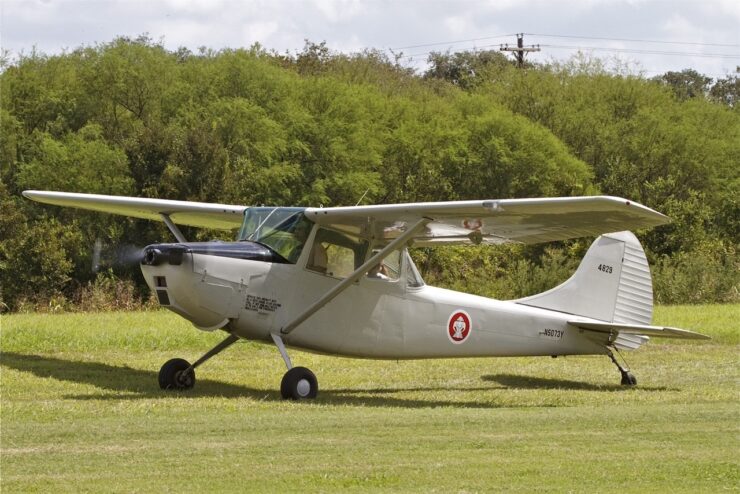In the summer of 1921, during a routine flight in the Sioux Lookout District of Ontario, Lieut. R. N. “Reg” Johnston spotted a forest fire on an island. He returned to base and picked up a ranger with the necessary fire-fighting tools. The fire was then extinquished before it got out of control. This appears to be the first documented case in Ontario of a situation where an aircraft was used in helping to suppress a fire.
Later, in 1944, Carl Crossley experimented with dropping water on fires from his KR-34 aircraft. He installed a 45 gallon tank in the front cockpit. He then converted a Norseman for waterbombing, using the floats to carry water, but found the water dispersed in a fine mist while falling through the air, having little effect on fires.
Crossley’s experiments led The Ontario Provincial Air Service to try a simpler system. They dropped water filled wax paper bags through a cargo hatch in the Beaver. This system proved equally ineffective as it was difficult to deliver a concentrated load of water. As well, if a bag scored a direct hit on a fire, the force of the impact sent embers flying and spread them, often worsening the situation!
Tom Cooke, a pilot employed by O.P.A.S. during the 1950’s, designed a water dropping design known as roll tanks. The tanks were attached the floats of Beavers and Otters with a forward facing pipe below the waterline. The line led the water up to the top of the tanks which were open. As the plane taxied, the tanks became filled. When the plane reached the fire, the tanks rolled to one side, spilling the water. This method delivered a small, but concentrated load on a fire, and proved effective in northern Ontario where there are many lakes, allowing the pilot to make many water drops in a short period of time.
Although roll tanks were a big improvement over earlier waterbombing methods, they had drawbacks; they had a limited carrying capacity and produced significant drag. Further development of aerial waterbombing design led back to the carrying of water directly in the pontoons.
Present-day aircraft

In Canada
In addition to specially built pontoons, there are now planes that have been specifically built for water bombing. Canadair has two aircraft types for this purpose.
The CL-215 was originally designed in the 1960s in response to criteria established by forestry officials who were looking for a more effective way of delivering water to suppress forest fires. The CL-215 was designed with an internal, 5346 litre (1410 gal. US) water tank system and, most importantly, could reload its tanks in seconds through two low-drag water scoops by skimming the surface of a nearby lake. The CL-415, although externally similar to its predecessor is quite a new machine. It features Pratt & Whitney turboprops, air-conditioned glass cockpit, and powered flight controls. Both aircraft are used by the Ministry of Natural
Resources Aviation Branch (formerly O.P.A.S.) in Ontario, as well as many firefighting agencies worldwide.
If you are in fond of firefighter’s jobs and want to try yourself in this sphere (which is in big demand in Ontario, as well as throughout Canada), browse Jooble for available entry-level and professional vacancies to take one more step leading to your dream.
Canadair CL-415

The CL-415 has increased operating weight and speed yielding improved productivity. Aircraft systems have been updated for easier maintainability. The CL-415 is ideal for Initial Attack on forest fires – getting to the fire at the earliest stages and repeatedly dropping large amounts of fire suppressing foam or water.
Both models can be fitted with onboard foam injection systems which allow the addition of foam to the water which enhances the fire suppressing capabilities of the water.
In the United States
Because of the diverse nature of the geography in the United States, aerial firefighting technology has been approached from a different angle.
Where Canadian forest areas are dotted with lakes, making waterbombing feasible, the American landscape in many cases is quite different. Most of America’s forests are in mountainous terrain with few accessible lakes, which makes the work of amphibious waterbombing dangerous, if not possible at all. This has led to the use of aerial tankers as the preferred fire retardant delivery system.
There is no shortage of surplus military hardware – both bombers and cargo aircraft. Many have been retrofitted with tanks to carry chemical retardants or suppressing foam.
Helicopters are often used to deliver extinguishing payloads into places where conventional, fixed-wing aircraft cannot travel. Small fires can be doused quickly and effectively using smaller helicopters with portable buckets. Where precision drops of large volumes of water or retardant are required, giant helitankers fill the need. (See picture and stats below)
In Scandinavia

Because Scandinavian countries are small in land area, a major forest fire would obviously be more devestating than in the larger boreal nations. However, this “smallness” is also an advantage. In Finland, for example, 50 to 150 forest fires are documented each year. Most are spotted in their early stages by passing commercial and private aircraft.
Quick-response is the key to firefighting policy. As typical fires are no more than a few hectares in size, they are quickly doused or impeded with water and fire-retardants from helicopters. Ground crews are then transported to the site for “mop-up” operations. In the case of larger blazes, helicopters are used again for waterdrops, as well as transporting manpower and equipment to sites, especially in more remote locations.
In Russia
Russia has launched a series of development activities in aerial fire control technology.
Antonov AN-2 P – This single-engine land airplane is well known among fire fighters. It is one of the planes used for smokejumping operations all over the CIS. The AN-2 P is a STOL (Short Take-Off and Landing) plane (“P” version is derived from “Pozharnik”, which means Fire Fighter). Its conversion to a water bomber was specifically designed to control wildfires in the regions contaminated by radionuclides. The extinguishant load is 1,200 l.
Antonov AN-26 – This transport plane is widely used in the civilian and military sector and in fire control operations (long distance transport of firefighters, aerial observation, rain seeding, smokejumping). One of the recent developments is the construction of external tanks for extinguishants: Two tanks, each of which with a capacity of 2 tons, can be attached to the plane and used for initial attack once a fire has been spotted. The tanks can be removed from the plane within a short space of time.
Berijev Be-12 PBerijev Be-12 P – Primarily a military amphibious airplane, a number of these planes have been converted to a firefighting version (BE-12 P). The plane is a scooping plane and carries up to 6 tons of water.
Berijev Be-200 P – This is a multipurpose amphibious aircraft which can be configured for fire fighting, passenger, and cargo transport. The two D-436 turbofan engines are top-mounted and allow the scooping of water for aerial delivery over forest fires. In addition to the capacity of 12 tons of water or retardants, a 1.2 cubic metre tank for liquid chemical is installed on the aircraft.
IL-TD – The Ilyushin IL-TD turbofan jet cargo aircraft is by far the world’s most formidable, fastest, longest-range, air tanker. (See picture and stats below)
Aircraft of note

“Bird Dog” Aircraft
Often overlooked in forest firefighting operations are the “Bird Dog” aircraft. They are called that because they act as the spotter, and lead waterbombers safely into the bombing pattern.
No specific make or model of plane exists that could be called the definitive Bird Dog aircraft; a large variety are flown by spotters around the world. What all have in common is the task. On a fire call, the Bird Dog is airborne within minutes and sets up contact with the ground-based fire boss and determines the fire location, size and nature.
Once the site has been assessed by the spotter, he radios back the information to the fire boss who directs the entire land and air firefighting operation. While enroute to the fire, the waterbomber or tanker receives instructions from the Bird Dog as to circuit altitude, drop height, and exit plan. The Bird Dog leads each loaded waterbomber directly over the fire site for its drop and may continue for as many drops as it takes to quench the flames.
Often pilots rotate between the waterbomber and Bird Dog aircraft so that they are proficient with both. It is most beneficial for the Bird Dog pilot to be familiar with the waterbomber requirements particularly in the waterbombing role.

